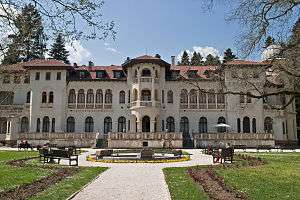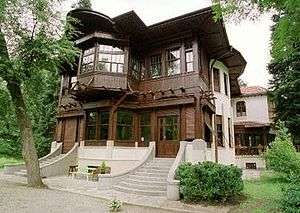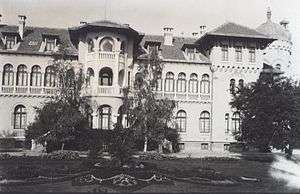Vrana Palace



Vrana Palace (Bulgarian: Дворец „Врана“, Dvorets „Vrana“) is a former royal palace, located on the outskirts of Sofia, the capital of Bulgaria. It is today the official residence of Tsar Simeon II of Bulgaria and his wife Tsaritsa Margarita. While the Royal palace in the centre of Sofia (today the National Art Gallery and National Ethnographic Museum) served representative purposes and the Euxinograd palace near Varna was a summer residence, Vrana was the palace where the royal family of Bulgaria spent most of their time. Vrana Palace is situated at an elevation of 571 m.[1]
The extensive lot was bought by Tsar Ferdinand I in 1898[2] and is situated just outside Sofia. There is a large park and two buildings, the first one built in 1904 as a two-storey hunting lodge commissioned to Georgi Fingov, and the second constructed mainly between 1909 and 1914 as a palace, both with money from the state budget. The earliest building in the complex, the hunting lodge, has been described architecturally as an "exquisite interpretation of the Plovdiv baroque with Viennese decorative elements".[3]
Three rooms of the three-storey palace commissioned to the noted architect Nikola Lazarov were later furnished in the Baroque style, one in the style of the Austrian royal palaces and one in a Bulgarian national style, while the study was designed in a Venetian style. The palace features a carved wooden ceiling, oak wainscoting, built-in metal plates and Delftware. The interior columns are made of Carrara marble and an old Schindler lift is still in use. In terms of architecture, the Vrana Palace combines Byzantine influences, Bulgarian National Revival traditions, Art Nouveau and French classicism.[3]
The Karelian Hall is a gift from Alexander III of Russia, and all of its furniture (the table, the chairs and the dressing table) are made of Karelian birch by master woodworkers specially sent from Russia. The first storey also has a cinema hall and tea halls, the second storey is where the apartments are located, and the third one used to be allocated to the servants and the court.
In 1918 Vrana passed from Tsar Ferdinand to Boris III. Here he faced the new government after the military coup on 9 June 1923. In August 1943, it became the property of Simeon II. The main palace was bombed by the RAF in 1943-44 during the World War II and after partially damaged, it was subsequently restored in 1947. After the abolition of the monarchy, Vrana was taken by the communists and became a residence of Georgi Dimitrov.
After the fall of the communist regime, Vrana was returned to the last tsar, Simeon Saxe-Coburg-Gotha and his sister Princess Maria Luisa, by the Constitutional Court of Bulgaria in June 1998, and the park was donated by the royal family to the city of Sofia in October 1999, making it possible for the former royal park, arranged in 1903 by Ferdinand,[4] to be opened to the public. Simeon moved with his wife Margarita into the renovated old hunting lodge in spring 2001. As of 2015, the 0.968-square-kilometre park is opened to the public. The park is home to over 400 plant species and has been declared a national monument of landscape architecture.[5] Among the landscape artists who have worked on the Vrana Park include V. Georgiev, K. Baykushev, Jules Locheau, Johann Kellerer, Anton Kraus, Alaricus Delmard and Wilhelm Schacht. The park includes a lake and several rock gardens.[3]
The palace, along with the other properties given back to Simeon II, has been the subject of much controversy in the Bulgarian media and society in the 2000s, as many argue they are in fact supposed to be public property. Since June 2013, the park has been opened to the public on weekends. The special public transport bus 505, which only runs on weekends during the park's opening hours, connects the palace with Eagles' Bridge.
References
General references
- Iliev, Dimitar; Bozhidar Dimitrov (2006-05-12). "Not a single royal lev for the construction of Vrana" (in Bulgarian). Standart News. Retrieved 2006-10-08.
- "Ferdinand bought Vrana for 600 leva. Vrana is the favourite family residence of the ruler." (in Bulgarian). Sega. 2004-01-22. Retrieved 2006-10-08.
Footnotes
- ↑ Vrana Palace Elevation and Location
- ↑ "Ferdinand bought Vrana for 600 leva. Vrana is the favourite family residence of the ruler."
- 1 2 3 "Vrana Park and Palace". H.M. King Simeon II. Retrieved 2009-08-12.
* "Парк и дворец "Врана"" (in Bulgarian). Н.В. Цар Симеон II. Retrieved 2009-08-12. - ↑ "The mayor: "I'm opening the Vrana park if a sponsor donates"" (in Bulgarian). 24 Chasa. 2006-02-16. Retrieved 2006-10-09.
- ↑ "Vrana Botanical Park. Vrana Park restoration and development project." (in Bulgarian). Capital Municipality website. Retrieved 2006-10-09.
Coordinates: 42°38′25″N 23°25′58″E / 42.6402777878°N 23.4327777878°E